Ecological Focus Areas
This is an old version of the page
This is an old version of the page
Date published: 15 October, 2015
Date superseded: 18 February, 2016
Table of Contents
- What is an Ecological Focus Area?
- I'm organic – am I exempt?
- Do the EFA requirements apply to me?
- What counts as arable land?
- How much does each of these options contribute to my EFA commitment?
- Where can I put my EFA?
- Mapping requirements – new for 2016
- Types of EFA
- EFA fallow land (EFAFAL)
- EFA buffer strips (EFABUF)
- EFA field margins (EFAFM)
- EFA catch crop (EFACC)
- EFA green cover (EFAGC)
- EFA nitrogen-fixing crops (EFANFIX)
- General tips for all EFA options
- Download guidance
What is an Ecological Focus Area?
An Ecological Focus Area is an area of land upon which you carry out agricultural practices that are beneficial for the climate and the environment. The main aim of an EFA is to improve biodiversity. There are six EFA options that can be used on their own or in combination to meet the EFA commitment:
- fallow land
- buffer strips
- field margins
- catch crops
- green cover
- nitrogen-fixing crops
If the EFA requirements apply to you, it means at least five per cent of your calculated arable area must be put into one or more of the six types of EFA. You will not be penalised for declaring and managing more than five per cent of EFA.
I'm organic – am I exempt?
- if 100 per cent of your land is organic, you don’t need to read this section as EFA requirements are not applicable to you
- if part of your holding is certified as organic the areas that are not certified as organic need to be considered for EFA requirements
- where businesses are only partly organic, you may choose not to benefit from the exemption for organic land. Instead you may choose to meet Greening requirements across all your arable land
Do the EFA requirements apply to me?
We have also compiled a table in Annex B, which you will find helpful in identifying your EFA requirements.
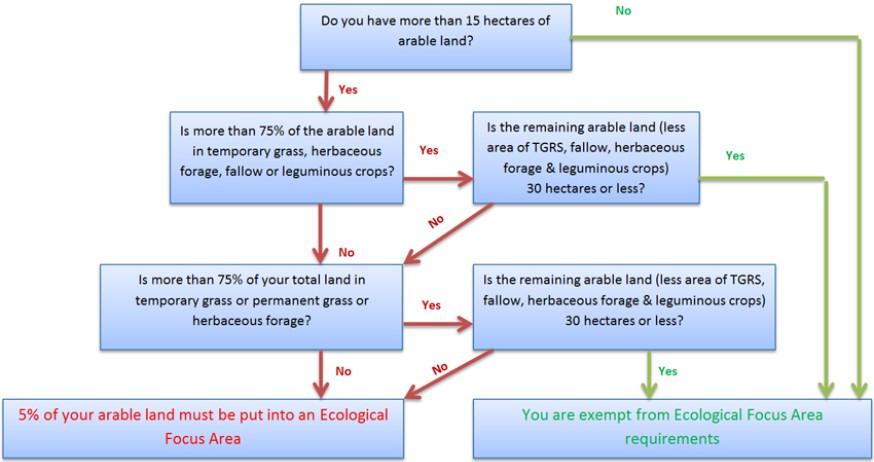
What counts as arable land?
For the purposes of calculating your EFA requirement, your arable land must include all of the land used to grow arable crops, fallow, temporary grassland, leguminous crops and herbaceous crops that you declare on your Single Application Form.
If you use some of your permanent grassland area as EFA (for example, a buffer strip or field margin, this means that this area of EFA on your permanent grassland is now classed as arable land. You will declare it as permanent cover on your Single Application Form and it will be added to your total arable area calculation. An example would be:
Total area of holding = 125 ha
Total arable area = 100 ha
EFA is 5% = 5 ha
If all the five hectares of EFA is sited on permanent grassland this would now become arable and would be added to give your new total arable area, for the purpose of Greening.
Therefore: (original total arable area) 100 ha + 5 ha (EFA) = 105 ha (new total arable area). New area of EFA required is now 5.25 ha.
All the arable land on your holding must be included in your calculation unless this is declared by another applicant for the Basic Payment Scheme and is included in their crop diversification calculation.
When calculating your arable area you should ensure that you include any land that is fallow, any land in an EFA buffer or EFA field margin and any land that is currently in an agri-environment scheme that does not allow production, which was formerly arable. For example:
- beetle banks
- grass margins
- water margins where grazing is excluded
These areas may currently be declared as LIEM-A (LFASS Ineligible Environmental Management).
Permanent crops are not included in the calculation of your arable area (see the Glossary for a definition of permanent crops).
How much does each of these options contribute to my EFA commitment?
The European Commission has set out a number of weighting factors for the different types of EFA which will contribute to each EFA option. These factors allow for the fact that certain types of EFA deliver higher levels of environmental benefit.
When calculating your EFA obligation you will measure the actual area of the EFA feature and multiply by the appropriate weighting factor to give the equivalent area of EFA. The weighting factors are:
| EFA | Location | Weighting factor |
|---|---|---|
| Fallow | On arable land | 1 |
| Buffer strips | On, adjacent to or within five metres of arable land | 1.5 |
| Field margins | On, adjacent to or within five metres of arable land | 1.5 |
| Nitrogen-fixing crops | On arable land | 0.7 |
| Catch crop | On arable land | 0.3 |
| Green cover | On arable land | 0.3 |
For example, spring barley under-sown with grass as a catch crop with a weighting factor of 0.3 – this means that 10 hectares of catch crop counts as three hectares towards your EFA requirements.
Where can I put my EFA?
To be eligible to support EFA the land must be:
- used by the claimant
- on a declared agricultural parcel
- on Basic Payment Scheme eligible land
You must locate your EFA fallow, EFA catch crop, EFA green cover and EFA nitrogen-fixing crops on arable land.
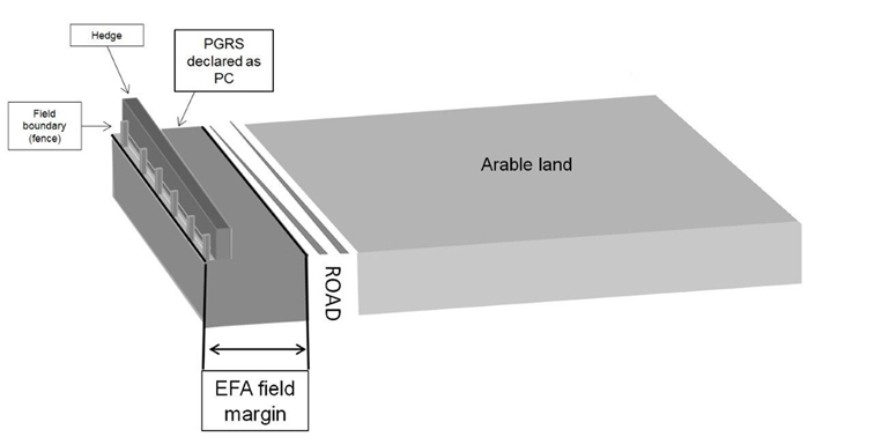
EFA Field margins and EFA Buffer strips must be on, adjacent to, or within five metres of arable land. This diagram is an example of a field margin on permanent grassland within five metres of arable land. In this example the road is less than five metres wide.
Mapping requirements – new for 2016
If you undertake any EFA on your holding you will be required to submit a map detailing the type, location and size of each EFA feature. Please see an example at Annex J, which was prepared using a blank map from Rural Payments and Services.
Types of EFA
The following sections describe each type of EFA. Each EFA option has its own unique management requirements. You should consider carefully which EFA options you wish to implement to suit your circumstances.
EFA fallow land (EFAFAL)
EFA fallow land is arable land that has no crop production or grazing on it from 15 January to the 15 July inclusive.
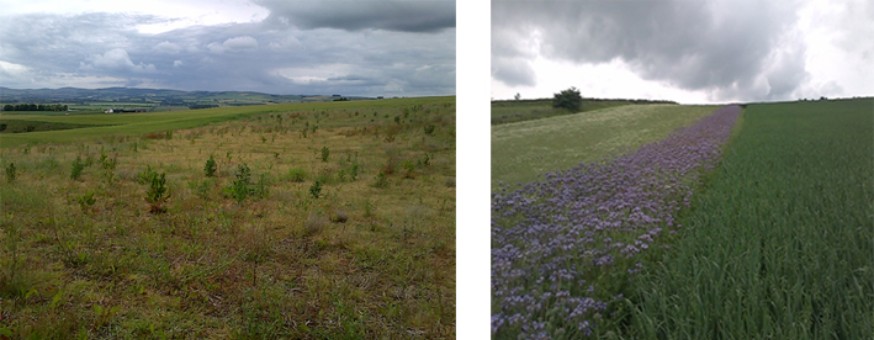
Above pictures: (left) EFA fallow - example of natural regeneration and (right) EFA fallow - example of wild flower mix (two species)
What land is eligible to support EFA fallow?
Your land:
- must be arable land
- must be on your holding, on a declared, BPS eligible, agricultural parcel and claimed on your Single Application Form
- must have been in the preceding year fallow or an arable crop (including temporary grass; years 1–4)
- must be a minimum of 0.01 hectares in size
- must be clearly identifiable and distinguishable on the ground from 15 January to 15 July inclusive
Requirements for EFA fallow
You must:
- submit an EFA map with your Single Application Forms, detailing the location and size of your EFA fallow land (see Annex J, EFA Maps)
- control injurious weeds, invasive weeds and other weed species by spot herbicide application or hand roguing (see details of GAEC in Overview)
You must not:
- undertake agricultural production between the dates of 15 January to 15 July inclusive. For example, this includes areas of land used in the establishment and growing of a crop
- you must not store materials (irrigation pipes, fuel bowsers, seed boxes)
- you must not use for the turning of machinery
- you must not use for access (except for occasional use) - undertake maintenance such as drainage between the dates of 15 January and 15 July inclusive
- change the land cover within the fallow period 15 January to 15 July inclusive with the exception of establishing a wild flower or wild bird seed mix
- top the fallow between the dates of 15 January to 15 July inclusive
- apply any fertiliser, except to aid in the establishment of a wild flower mix or wild bird seed mix in the area of fallow from 15 January to 15 July inclusive
- apply any pesticides to the area of fallow from 15 January to 15 July inclusive, except by spot herbicide application to control injurious weeds; (refer to Overview for guidance on GAEC requirements)
You are allowed to:
- change the ground cover to establish a wild flower or wild bird seed mix within the fallow area
- temporarily store farm yard manure for that field
|
Helpful tips for EFA fallow land • if you choose to put temporary grass in fallow the land retains its arable status for the period it is claimed as EFA fallow even if the grass is more than five years old • if you’ve claimed temporary grass as EFA fallow in one year and decide not to claim this as EFA fallow in the following year, it will revert to being temporary grass if it’s five years or younger, or permanent grass if it’s older than five years • if you are unsure if your use of an area for access or tracking is more than occasional use i.e. rights of way, then you should not use this as an EFA fallow area • you may be asked to provide a seed label if one element of your wild bird seed mix or wild flower mix fails, to prove eligibility • if weed control is a problem, then you may consider establishing a wild flower mix or wild bird seed mix to aid weed control. Please see Overview for guidance on GAEC requirements |
EFA buffer strips (EFABUF)
Buffer strips are areas of land that help to benefit water quality and biodiversity from 1 January to 31 December inclusive.
What land is eligible to support EFA buffer strips?
Your land:
- must be on, adjacent to, or within five metres of arable land in such a way that their long edges are parallel to the water course being buffered
- must be on your holding, on a declared, BPS eligible, agricultural parcel and claimed on your Single Application Form
- must provide a buffer to a water course
- must be between two and 20 metres wide
- does not need to meet the water’s edge but must stop at the water’s edge
- must be a minimum of 0.01 hectares in size
- must be clearly identifiable and distinguishable on the ground from 1 January to 31 December inclusive
Requirements for EFA buffer strips
You must:
- submit an EFA map with your Single Application Form, detailing the location and size of your EFA buffer strips (see Annex J, EFA Maps)
- control injurious weeds, invasive weeds and other weed species by spot herbicide application or hand roguing (although you must not breach GAEC – refer to section Overview for guidance on GAEC requirements)
You must not:
- undertake agricultural production from 1 January to 31 December inclusive
- carry out topping, as any left material could provide a source of nutrients, which could get into the water course
- graze the EFA buffer strip from 1 January to 31 December inclusive
- apply any pesticides to the EFA buffer strip with the exception of herbicide for the spot treatment of injurious weeds. Please see Overview for guidance on GAEC requirements
- clean ditches and spread the spoil on any area which has been claimed as an EFA buffer strip
You are allowed to:
- change the cover to establish a wild flower mix, wild bird seed mix or a grass sward
- cut for silage or hay. But if you cut the EFA buffer strip, you must remove all cuttings
|
Helpful tips for EFA buffer strips • the EFA buffer strip may include eligible landscape features such as hedges (up to three metres wide) • if the area of the EFA buffer strip includes land ineligible for your Basic Payment this must be deducted from the area of the buffer strip claimed • any permanent grassland claimed as an EFA buffer strip is considered as ‘arable’ for the purposes of the EFA arable calculation and should be declared as Permanent Cover (PC) on your Single Application Form • if you intend to top these areas you should claim and manage these areas as EFA field margins, which provides this flexibility • when cutting you should be sympathetic to ground nesting birds by avoiding nesting periods |
Examples of EFA buffer strips
The following illustrations are examples of EFA buffer strips, however you should note these are indicative examples to help you when considering your EFA requirements. If you are unsure if your chosen area is eligible to count towards an EFA buffer strip, please contact your local area office with details and they will provide further guidance.
Example one – EFA buffer strip adjacent to arable land
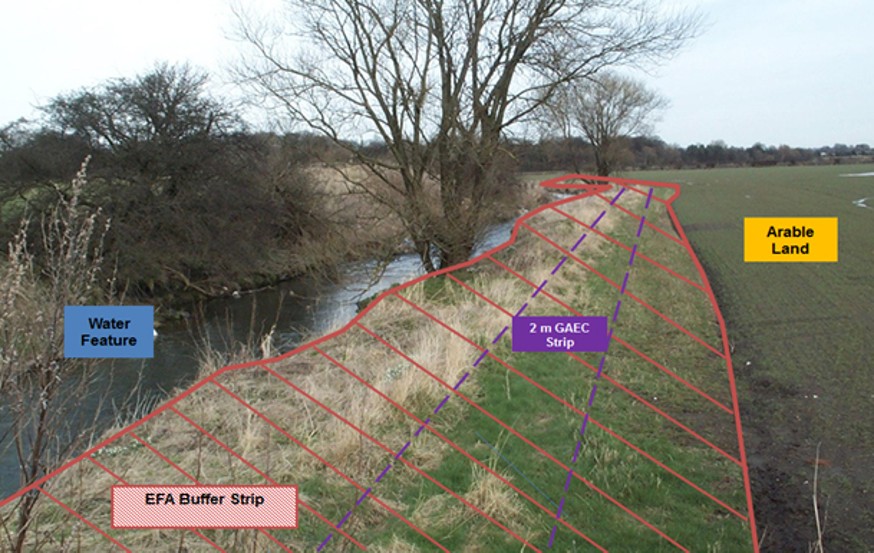
The EFA buffer strip starts at the edge of the arable land and runs parallel with the water feature. The EFA buffer strip stops at the water’s edge. The EFA buffer strip must be between two and 20 metres wide. It does not need to meet the water’s edge but must stop at the water’s edge.
There is a requirement to maintain a two metre wide, uncultivated buffer strip at the top of the bank. This is part of the Good Agricultural and Environmental Condition (GAEC), this can be included in the EFA buffer strip area. Please see Overview for guidance on GAEC requirements).
In this example the defined edge of the EFA buffer strip is the start of the cropped field and the width of the EFA buffer strip must be between two and 20 metres wide.

Example two – EFA buffer strip including arable land
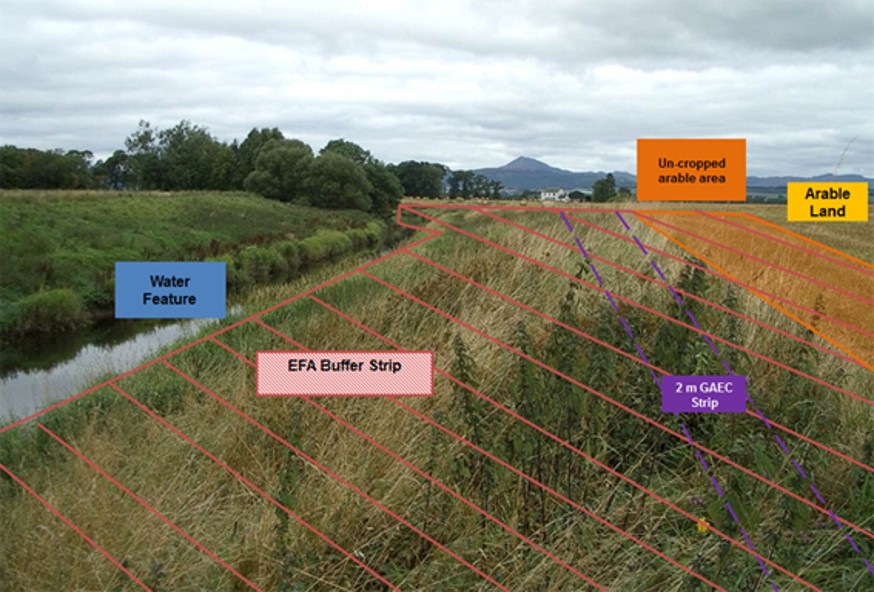
The EFA buffer strip starts on the arable land. There is a requirement to maintain a two metre wide, uncultivated buffer strip at the top of the bank.
This is part of the Good Agricultural and Environmental Condition (GAEC), this can be included in the EFA buffer strip area. Please refer to Overview for guidance on GAEC requirements.
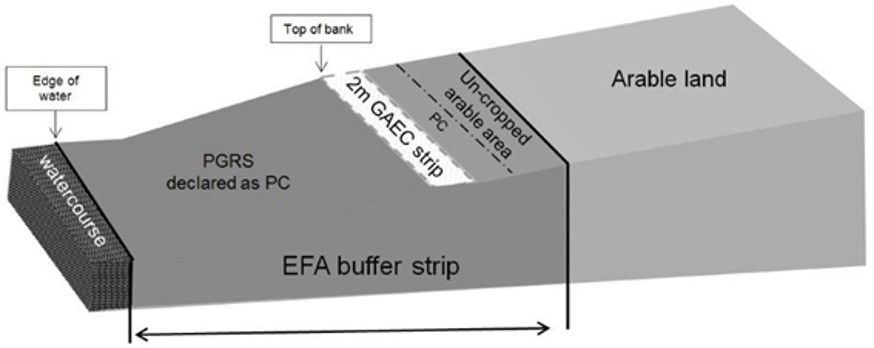
In this instance the farmer has chosen to extend the EFA buffer strip into the arable field and will leave this area in stubble (natural regeneration) for the duration of the claimed period (at least 1 January to 31 December inclusive).
EFA field margins (EFAFM)
Field margins provide an important habitat for farmland biodiversity and contribute to wildlife and ecological networks from 1 January to 31 December inclusive.
What land is eligible to support EFA field margins?
Your land:
- must be on, adjacent to, or within five metres of arable land
- can be around the margin of a field or splitting two crops within a field
- must be on your holding, on a declared, BPS eligible, agricultural parcel and claimed on your Single Application Form
- must be between one and 20 metres wide
- must be a minimum of 0.01 hectares in size
- must be clearly identifiable and distinguishable on the ground from 1 January to 31 December, inclusive
Requirements for EFA field margins
You must:
- submit an EFA map with your Single Application Form, detailing the location and size of your EFA field margins. Please see Annex J
- control injurious weeds, invasive weeds and other weed species by spot herbicide application or hand roguing. You must not breach GAEC – refer to Overview for guidance on GAEC requirements
You must not:
- undertake agricultural production from 1 January to 31 December inclusive
- graze the EFA field margin in the period 1 January to 31 December inclusive
- apply any pesticides to the EFA field margin with the exception of herbicide for the spot treatment of injurious weeds, invasive weeds and other weed species. Refer to Overview guidance on GAEC requirements)
- apply any fertiliser with the exception that you may apply fertiliser to aid the establishment of wildbird seed mix, wildflower mix or grass
You are allowed to:
- change the cover to establish a wildflower mix, wildbird seed mix or a grass sward
- apply fertiliser to aid establishment of wildbird seed mix, wildflower mix or grass
- carry out topping after 31 August, but the cut material must not be removed. (i.e. EFA field margin cannot be used for hay or silage)
|
Helpful tips for EFA field margins • hedges and ditches defined as eligible landscape features (hedges up to three metres wide and ditches up to two metres wide) under GAEC, may be included as part of an EFA field margin • if you have existing beetle banks created under a previous Agri-Environment Scheme this can be included in an EFA field margin. However this may result in potential double funding and a reduction in your agri-environment payment • if land was sown out a number of years previously and is now permanent grassland (i.e. more than five years old) the area is still eligible for an EFA field margin if it is within five metres of arable land • if the area of the EFA field margin includes land ineligible for your Basic Payment this must be deducted from the area of the EFA field margin claimed • any permanent grassland claimed as an EFA field margin is considered as ‘arable’ for the purposes of the Greening calculation (EFA and crop diversification) and should be declared as permanent cover on your Single Application Form • if the EFA field margin splits two crops these can be the same crop (such as a field of winter barley split in two by an EFA field margin) • you must ensure that the EFA field margin is maintained from 1 January to 31 December inclusive, in the claimed year. If, for example, the crop in the field is grass, cropped as silage and you wish to graze the aftermath before 31 December inclusive, you must exclude stock from the EFA field margin |
Examples of EFA field margins
The following illustrations provide examples of EFA field margins. Please note – these are indicative examples to help you when considering your EFA requirements. If you are unsure if your chosen area is eligible to count towards an EFA field margin, please contact your local area office with details and they will provide further guidance.
Example one – EFA field margin in an arable field
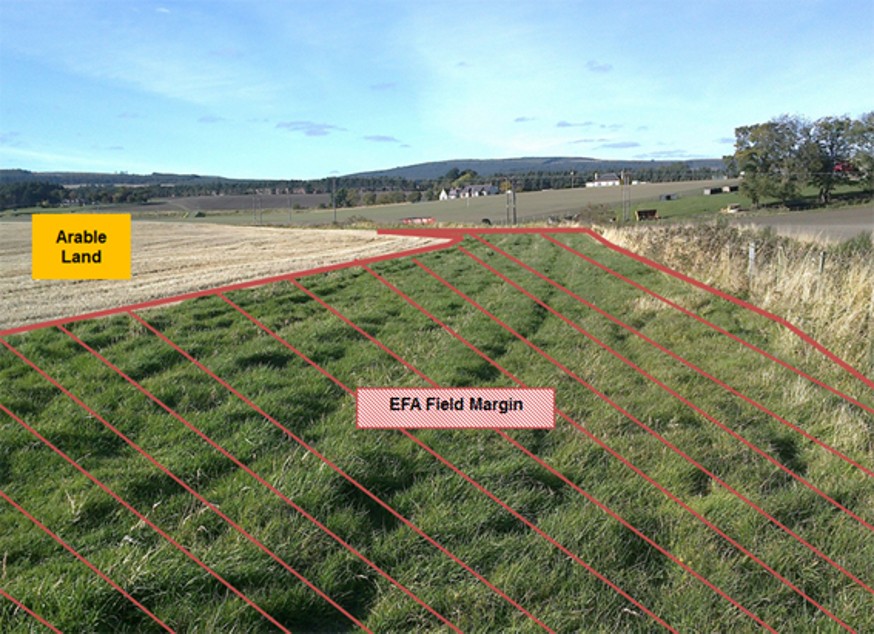
Above is an existing grass field margin (possibly a former agri-environment option or a field margin established in grass) running from the fence to the edge of an arable crop. The EFA field margin is between one and 20 metres wide on arable land and will not be subject to agricultural production for the period 1 January to 31 December inclusive.
Example two – EFA field margin adjacent to hedge including GAEC strip
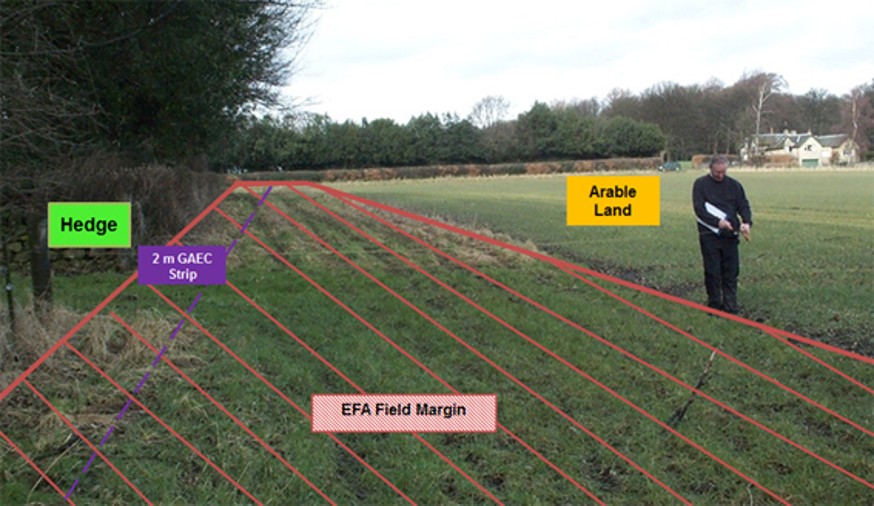
The example above is an EFA field margin (on which the farmer has chosen to establish grass) running from the centreline of the hedge to the edge of an arable crop. The EFA field margin is between one and 20 metres wide on arable land and will not be subject to agricultural production for the period 1 January to 31 December inclusive.
In this instance there is a GAEC requirement to maintain a two metre wide, uncultivated strip from the centre line of the hedge (as detailed above). The two metre GAEC strip can be included in the EFA field margin. (refer to Overview for guidance on GAEC requirements.
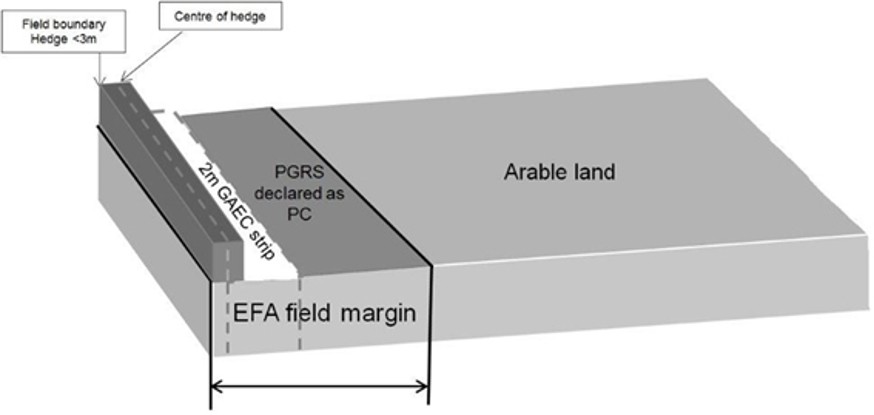
Example three – EFA field margin including GAEC and Basic Payment Scheme eligible landscape feature

In the example above, the farmer has chosen to include an area from the fence to the edge of the cropped land including, as part of the EFA field margin, the water feature as it is less than two metres wide (a Basic Payment Scheme eligible landscape feature) and the two metre wide, uncultivated GAEC buffer strip for the water feature.
The two metre wide GAEC buffer strip starts at the top of the bank (not from the water’s edge). Refer to Overview for guidance on GAEC requirements.
This permanent grassland, if claimed as an EFA field margin is considered as ‘arable’ for the purposes of the Greening calculation (EFA and crop diversification) and should be declared as Permanent Cover (PC) on your Single Application Form.
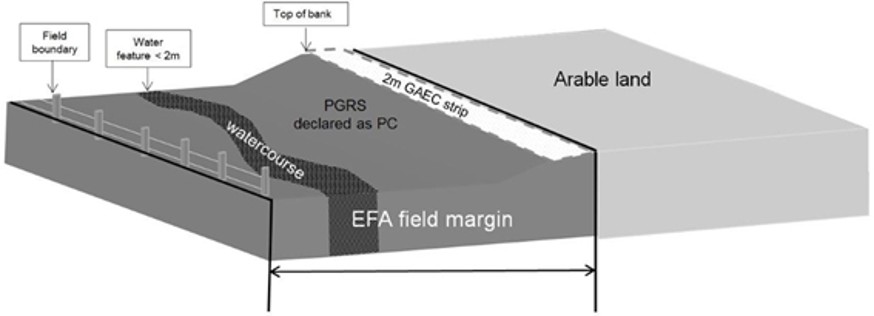
EFA catch crop (EFACC)
In Scotland, the only catch crop you can grow will be a cereal nurse crop with under sown grass as the catch crop. A catch crop will provide an enhancement to biodiversity and prevent soil erosion.

Pictures above: EFA catch crop - barley under-sown with grass
What land is eligible to support EFA catch crop?
Your land:
- must be arable land
- must be on your holding, on a declared, BPS eligible, agricultural parcel and claimed on your Single Application Form
- must be a minimum of 0.01 hectares in size
- must be clearly identifiable and distinguishable on the ground
Requirements for EFA catch crop
You must:
- submit an EFA map with your Single Application Form, detailing the location and size of your EFA catch crop. See Annex J for more information
- the main crop will be under sown with a recognised grass seed mix
- establish the EFA catch crop between 1 March and 1 August inclusive
- retain the EFA catch crop until 31 December, inclusive
You must not:
- incorporate and sow any EFA catch crop to a winter crop in the autumn (prior to 31December) of the year that it is claimed as an EFA
You are allowed to:
- graze the EFA catch crop after harvest of the main crop
|
Helpful tips for EFA catch crop • the only catch crop you can grow will be a cereal nurse crop with under sown grass as the catch crop • arable Silage for Stock Feed (ASSF) is not eligible for EFA catch crop, as it is not a main crop as defined in the Regulations • it would be helpful to retain the seed label to prove eligibility, if your EFA catch crop fails |
EFA green cover (EFAGC)
Green cover is the establishment of a temporary crop in the autumn that will provide an enhancement to biodiversity, improve soil structure, prevent soil erosion and will be incorporated before the establishment of the following years’ harvestable crop.
What land is eligible to support EFA green cover?
Your land:
- must be arable land
- must be on your holding, on a declared, BPS eligible, agricultural parcel and claimed on your Single Application Form
- must be a minimum of 0.01 hectares in size
- must be clearly identifiable and distinguishable on the ground
Requirements for EFA green cover
You must:
- submit an EFA map with your Single Application Form, detailing the location and size of your EFA green cover.See Annex J for more information
- establish the EFA green cover between 1 March and 1 October inclusive
- maintain the EFA green cover up to the 31 December inclusive
- incorporate the EFA green cover as a soil conditioner before establishment of the following years’ harvestable crop
- establish a green cover consisting of two or more of only the following crops: alfalfa, barley, clover, mustard, oats, phacelia , radish, rye, triticale, vetch
You must not:
- incorporate and sow any green cover to a winter crop in the autumn (prior to 31 December) of the year that it is claimed as an EFA
- use EFA green cover to support any agricultural production prior to incorporation; e.g. no cutting or grazing
|
Helpful tips for EFA Green cover • you may be asked to provide a seed label to prove eligibility, if one element of your EFA Green cover fails • if you intend to sow your EFA green cover immediately after harvesting another crop, you must remember you are required to establish it by 1 October. If you are in any doubt about your ability to establish the crop by 1 October you should choose another EFA option |
EFA nitrogen-fixing crops (EFANFIX)
These are plants that contain symbiotic bacteria called Rhizobia within the nodules of their root systems, producing nitrogen compounds that help the plant to grow and compete with other plants. When the plant dies, the fixed nitrogen is released; making it available to other plants and this helps to fertilize the soil.
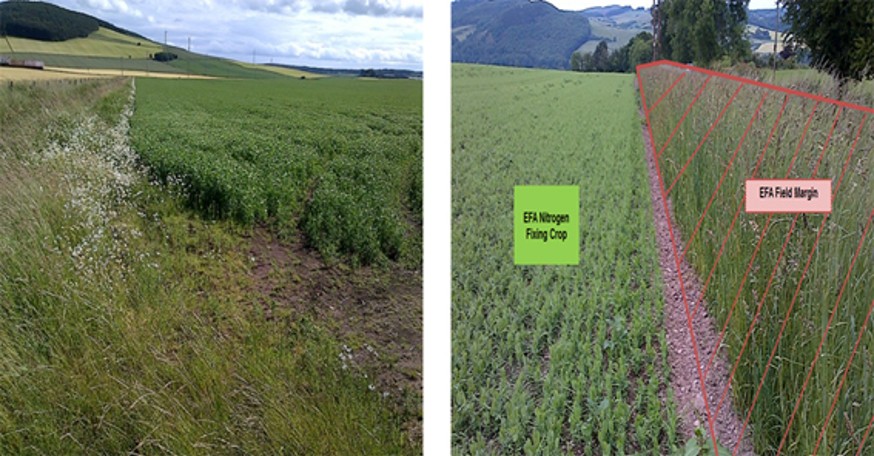
Pictures above: EFA nitrogen fixing crops with associated claimed EFA field margins
What land is eligible to support EFA nitrogen-fixing crops?
Your land:
- must be arable land
- must be on your holding, on a declared, Basic Payment Scheme- eligible, agricultural parcel and claimed on your Single Application Form
- must be a minimum of 0.01 hectares in size
- must be clearly identifiable and distinguishable on the ground
Requirements for EFA nitrogen-fixing crops
From 2016 there is an additional requirement to ensure that there are at least two different, claimed EFA nitrogen-fixing crops on your EFA area to extend the flowering period for pollinators.
You must:
- Grow two or more of the following nitrogen-fixing crops:
- alfalfa
- beans (including Faba beans)
- birdsfoot trefoil
- chickpea
- clover
- lentil
- lupin
- peas
- vetch - submit an EFA map with your Single Application Form, detailing the location and size of your EFA nitrogen-fixing crops. Please see Annex J
- ensure that all your claimed EFA nitrogen-fixing crops are surrounded by a claimed EFA field margin. The field margin must meet the EFA field margin rules, including retention and management until 31 December inclusive
- claim two distinct crops, that should be grown independently of each other and not as a mixture
- ensure that the main nitrogen-fixing crop is less than 75 per cent of the total area of nitrogen fixing crops declared as EFA
You must not:
- harvest the crop before 1 August in order to protect ground nesting birds
|
Helpful tip for EFA nitrogen-fixing crops • the associated EFA field margin must meet the EFA field margin rules and be claimed as EFA. If you wish to graze the aftermath of the nitrogen-fixing crops, livestock must be excluded from the EFA field margin from 1 January to 31 December inclusive. |
General tips for all EFA options
- land managed for EFA as field margins, fallow and buffer strips are not eligible for LFASS payments
- if you use temporary grass as EFA fallow, this land will retain its arable status for Greening purposes (including your commitment to have five per cent of your arable land subject to EFA and crop diversification). This applies for as long as you continue to use it for EFA fallow even if the grass becomes more than five years old
- remember – your arable land includes any temporary grassland that you include in a crop rotation. Temporary grassland is grassland that is five years old or less. If you plough permanent grass and immediately sow a new grass ley, the land will retain its status as permanent grass and does not become temporary grass
- if you choose to claim an EFA buffer strip or EFA field margin on permanent grassland, open grazed woodland or rough grazing – they must be on, adjacent to, or within five metres of arable land. You must declare this land as Permanent Cover (PC) on your Single Application Form. This permanent cover will be considered as arable land when calculating your total area of arable land for your Greening requirements including the area of EFA
- if you wish to undertake multiple EFA options in one field you can do this as long as you meet all the eligibility requirements of each and you are able to distinguish the location and extent of each option. In a practical example, this means you could have an area of fallow surrounded by a field margin
- land can only count once as EFA so as detailed above you may have different EFA options in the same field but the land can only contribute to your EFA commitment once; for example it cannot be EFA Fallow and EFA Green cover in the same claim year
- many elements of EFA are complementary to Good Agricultural and Environmental Condition (GAEC). This means that field margins and buffer strips along water courses or hedges can meet both GAEC and EFA requirements and be eligible land for the Basic Payment Scheme. Refer to Overview for guidance on GAEC requirements
- there is no upper limit to the area you can manage and declare as EFA. So if you have a commitment of 10.6 hectares you can manage and declare above this figure. For example, 12.2 hectares, if you wish
- if you want to include areas in your EFA that are currently part of an Agri-environment Scheme you can do this. However:
- you must ensure that the management of the two schemes are compatible (noting some Agri-environment Schemes require land to be grazed which would not be compatible with. For example, EFA field margins or EFA buffer strips)
- the payment you receive for your Agri-environment Scheme may be reduced to reflect the greening payment you receive for your EFA feature there may be delays in the payment of your Basic Payment as both schemes will need to be validated
Download guidance
Click 'Download this page' to create a printable version of this guidance you can save or print out.
